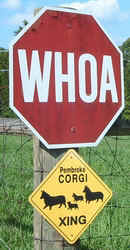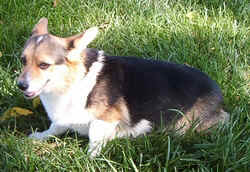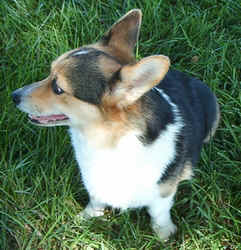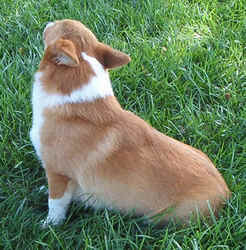
Corgi

 |
 |
|
 |
Description:
The Pembroke Welsh Corgi is a long, low dog with large erect ears, a broad flat skull and a fox-like head. The tail is almost non-existent. (The Cardigan variety has a long tail.) The Pembroke's eyes are dark, preferably with black rims, and the nose is black. The soft, water-resistant coat comes in red, sable, fawn or black & tan, usually with white markings. Some differences between the Pembroke and the Cardigan are: the Pembroke usually has straighter legs as it is not quite as long- bodied as a Cardigan; the Pembroke's head is generally more wedge-shaped; the ears are smaller and closer together than the Cardigans; also the Pembroke tends to be lighter than the Cardigan. Temperment: The Pembroke Welsh Corgi is a hardy, highly intelligent, obedient, protective and devoted dog. Corgis are extremely active and devoted little dogs, and are usually good with considerate children. They make fine guards, and excellent show and obedience dogs. Wary of strangers, it should be properly socialized and trained when it is still young - to avoid over-protective behavior as an adult. Some Pembrokes are more outgoing, restless and excitable than the Cardigan Welsh Corgi. Several of these brave dogs have lost their lives defending their homes, as they were too small for the situation. They sometimes try to herd people by nipping at their heels, although they can be trained not to do this. The Pembroke tends to bark a lot and makes a good alarm dog. Males can be aggressive with other males, particularly if a bitch in heat is in the vicinity. Size: Height: Dogs 10-12 inches (25-30cm) Bitches 10-12 inches (25-30cm) Weight: Dogs 25-30 pounds (11-14kg) Bitches 24-28 pounds (11-13kg). Health Problems: Prone to PRA, glaucoma and back disorders. Do not overfeed this breed, as it tends to gain weight easily. Living Conditions: The Pembroke will do fine in an apartment if they are sufficiently exercised. This breed is very active indoors and will do okay without a yard. They will do okay in most climates. Exercise: Naturally active little dogs, they should always be encouraged to remain so. Life Expectancy: About 12 - 15 years. Grooming: The soft, medium-length water-resistant coat is easy to groom. Comb and brush with a firm bristle brush, and bathe only when necessary. The coat is shed twice a year. Origin: The Pembroke and the Cardigan Welsh Corgis have been considered separate breeds for only about 70 years. There are several theories about the origins of the Welsh Corgi. Both Corgi varieties may be descended from Swedish Vallhunds brought to Wales by Vikings in the 800's. Or perhaps the Cardigan is the older variety, brought to Wales by the Celts in about 1200 BC. The name "Corgi" comes from the Celtic word for dog. Another source claims that the Pembroke varieties were brought to Wales by Flemish weavers in the 1100's. No matter what the breed's true early history, the Pembroke Welsh Corgi breed developed in Pembrokeshire, Wales, and was used to drive cattle by nipping their heels and barking. His low stature helped him roll out of the way when a cow kicked. Corgis still maintain that habit when chasing each other. The Pembroke and Cardigan varieties were freely interbred until the 1930's, after which time breeders tried to accentuate their differences. A Pembroke Welsh Corgi is well-known as the favorite breed and pet of Queen Elizabeth II. Because of royal favor, and perhaps because of a slightly gentler personality, the Pembroke Welsh Corgi has become very popular, while the Cardigan is not as widespread. Some of the Pembroke's talents include: herding, watchdogging, guarding, and competitive obedience. Group: Herding, AKC Herding. [Dog Breed Info Center]